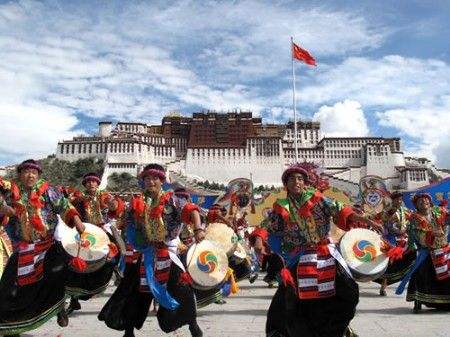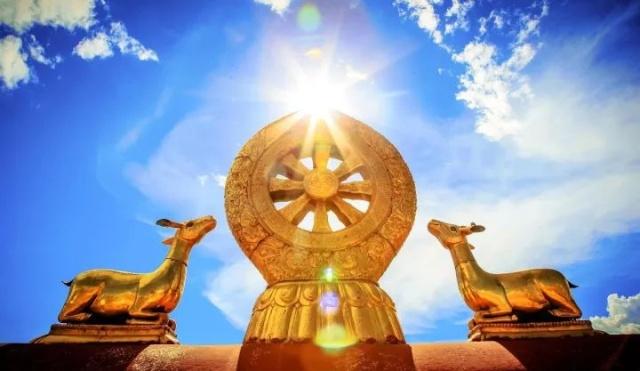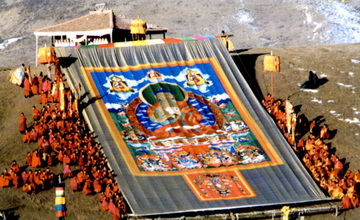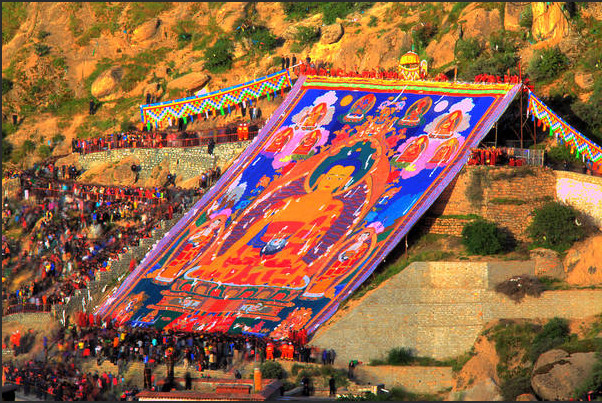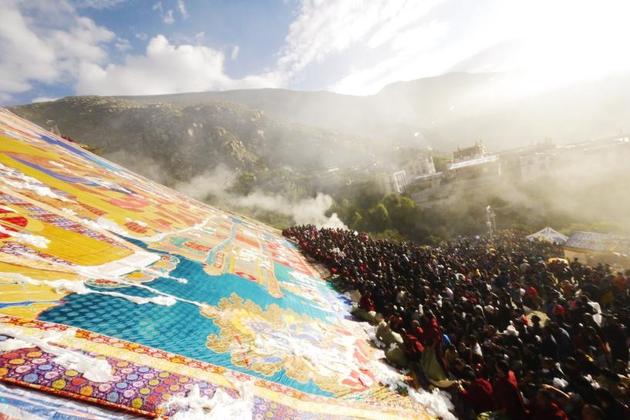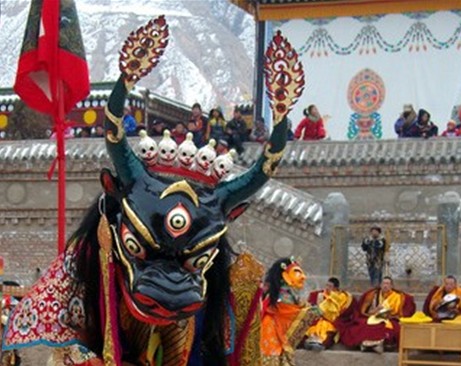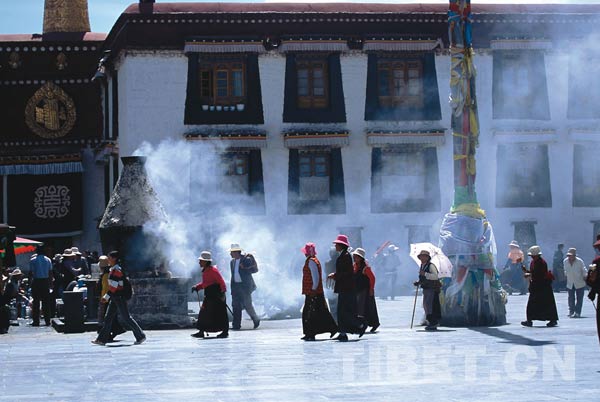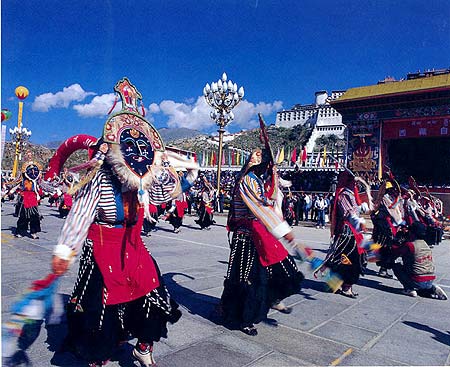Shoton Festival
Background of Shoton Festival
When the summer retreat for their intensive training is over, monks are served with yoghurt. That is said to be the origin of 'Shoton', which is also called the 'Yoghurt Festival'. At Drepung Monastery there are 'Cham' dances and the grand thangka is unveiled early in the morning. After devoutly viewing the thangka, the people go onto Norbulingka and other popular spots for a lingka (picnic). 'Shoton' is also known as the 'Tibetan Opera Festival' due to the competitive performances of Ache Lhamo (Tibetan Opera) that are held at Norbulingka. It is the opera festival and the greatest festivals in Tibet. In ancient times pious folks went into mountain hermitages for penance, and on the last day of which Yoghurt was served for meal followed by entertainment of folk songs and dances. Since 7th century, opera performances were held for days in Norbulingka. Presently, opera contests and distribution of prizes are held for seven days. Shoton means yoghurt. The legend was that TsongKhapa, and founder of the Yellow Sect made a rule that all the Lamas must keep the mind on meditation from the fourth month to the sixth month of Tibetan calendar. 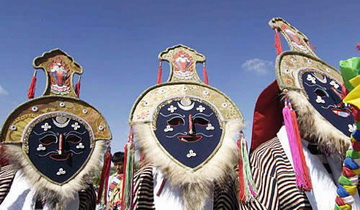 Abstinence is broken by the end of sixth month. Then they may go out and ordinary people would give them yoghurt in charity and have picnic and entertainment hence the festival. Later it became theatrical festival of Tibetan opera. So it is also called Tibetan Opera Festival. During the Shoton Festival, teams of Tibetan operas and theatrical troupes would come to Norbulingka to give performances. There is also trade fair here. The Shoton (or Xuedun) Festival is one of the grandest festivals in Tibet.
Abstinence is broken by the end of sixth month. Then they may go out and ordinary people would give them yoghurt in charity and have picnic and entertainment hence the festival. Later it became theatrical festival of Tibetan opera. So it is also called Tibetan Opera Festival. During the Shoton Festival, teams of Tibetan operas and theatrical troupes would come to Norbulingka to give performances. There is also trade fair here. The Shoton (or Xuedun) Festival is one of the grandest festivals in Tibet.
Popular fairs are also organized during the festival. Sholdon is the transliteration of two Tibetan words which means "the Yoghurt Banquet"in Tibetan. The festival is for eating yoghurt. The reason of the connection between Shoton and yogurt has a long history. There are more than 300 pieces of regulations in Tibetan religious tenets and the most important is to avoid killing. In summer, all the animals come out for food and it is easy to kill those small worms , so during the period from 15th in June to 30th in July, the Lamas are ordered not to do anything but stay in their monastery for penance, which is called 'Yale' in Tibetan language. However, staying inside the monastery for the whole day means not enough food for these lamas and it is said that the livestock of the family offering yogurt to lamas will be free of disease and can never get lost, nor were eaten by wild animals. With these known by more and more people, offering yogurt to lamas became a common activity during Shoton festival. For a whole week in early July when Venus appears in the sky every year, Tibetans will bathe themselves in rivers across the region all day long, believing that bathing may cure illness and get rid of misfortune at a time as water is purest and mildest. According to a Tibetan myth, the gods will descend from the heaven on the 22nd of the ninth month of the Tibetan calendar every year. All monasteries will be open on this day to the needy and prayers and sutra chants will be given.
History of Shoton Festival
Shoton Festival, (Xuedun festival), is one of the major traditional festivals in Tibet highland, featuring in opera performances, song singings and other local shows.
It was said that the festival can be traced back to the 11th century. When Master Atisha (a monk from Bengal) was dwelling and studying in Nethang Monastery in one summer, he set up rules for his students to follow, and one of the set rules is that Lamas should not leave monastery to enjoy funs in the case of protecting little creatures of the nature from being trampled to death.
In the 11th century, Buddhism was getting recovery from the heavy hit of King Darmo (the Tibetan king in 9th century who issued harsh laws to prohibit the spreading and any religious activities in Tibet highland in favor of his party). People between mid 9th and mid 11th century had suffered a lot from the continuous and disatrous wars and rebellions and all prayed to God to wish for peaceful life. In histroy when Buddhism was in power, people's lives would be better and suffer less, and Buddhism rituals advocate people to love little creatures, to respect the exisitance of lives and call on people to love each other and forget the hatred, revenge. At Atisha's time, it was time to sow seeds of life and spreading Buddhism in this suffering highland, and what Atisha dedicated himself to is to meet the spiritual needs of ordinary people, so he got great respect and it was him who began the refusion of Buddhism in this snowland 200 years after Darmo rooted Buddhism out. During that period in which Atisha and his students stayed inside the monastery, the locals around and Buddhism followers would offer them their best family-made Yoghurt, fruit and other seasoning food for the sacriface to their spiritual master and a way to show their respect.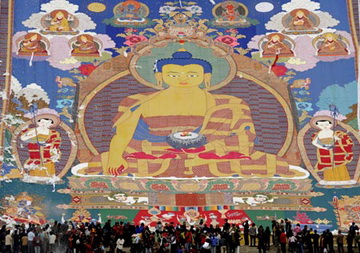
In the 17th century when Gelupa defeated Kargyuelpa's power and began to rule over Tibet, the Fifth Dalai Lama ordered the operas to be peformed in Drepung Monastery, Potala Palace and Norbulingka. And during the celebration, yoghurt was served, local style operas and songs were performed. With time going, it gradually became one of the most important and grandest festival in Tibet prior to Tibet New Year.
In history, Shoton festival was held in Drepung Monastery. That was because when Gelupa established his power over Tibet, the religious and political center was in Drepung Monastery, the Ganden Pochan was the reseidence for 5th Dalai Lama once. After Potala Palace was rebuilt in 1682, he moved his palace to Potala from Drepung Monastery. And since then, Shoton festival was performed first in Potala palace , then shifted to Drepung Monastery. At the time of 7th Dalai Lama, Norbulingka was built, he ordered the Shoton festival to be performed in his newly built summer palace after Drepung Monastery. And that's why every year when Shoton festival is about to begin, Drepung Monastery and Norbulingka become the center of public focus.
Buddha Painting Show
"Buddha Show " is a main and important activity during Shoton Festival. 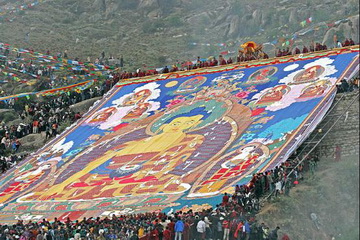 In dawn, a lot of Lamas of Drepung Monastery spread out the giant 'Thangka' of Buddha. When the 'Thangka' is spread out, the sun would be blazing through the morning mist whether the weather is sunny or overcast, and shines at the gaint 'Thanka" of Buddha, which is called the combination of deities and mankind. Then thousands of followers hold their breath and feel the baptism of their hearts. Next, horns blare, all Lamas read the scripture and pray, followers present Khada to the 'Thangka' and touch the 'Thangka' by forehead to show devotion. Then people come to Norbulingka, walk to own relatives' and friends' tents, and serve each other yak-butter tea and highland barley wine. People would sing and dance through the night. Shoton Festival is also called Buddha-Show Festival or Tibetan Opera Festival.
In dawn, a lot of Lamas of Drepung Monastery spread out the giant 'Thangka' of Buddha. When the 'Thangka' is spread out, the sun would be blazing through the morning mist whether the weather is sunny or overcast, and shines at the gaint 'Thanka" of Buddha, which is called the combination of deities and mankind. Then thousands of followers hold their breath and feel the baptism of their hearts. Next, horns blare, all Lamas read the scripture and pray, followers present Khada to the 'Thangka' and touch the 'Thangka' by forehead to show devotion. Then people come to Norbulingka, walk to own relatives' and friends' tents, and serve each other yak-butter tea and highland barley wine. People would sing and dance through the night. Shoton Festival is also called Buddha-Show Festival or Tibetan Opera Festival.
Buddha worship festival held in noted Tibetan monastery
As the first ray of sun glow touched Zhaibung Temple in Lhasa, thousands of local worshippers and tourists from afar on the road to the monastery viewed an imposing scene of praying to a Buddha portrait printed on a huge cloth piece.
The 20-meter long portrait of Buddha was gradually unfurled before viewers in a cloud of incense, a shower of camera flashes and exclamations of wonder. 
Worshipers threw silk Kha-btags at the Buddha portrait and prayed for safety and happiness.
The ceremony, known as Zhanfo, which means Buddha worship, marks the start of Tibet's annual Shoton Festival.
The Shoton Festival, which is also called the Tibetan Opera Festival, is held annually from the end of the sixth month to the middle of the seventh month in Tibetan calendar. The word Shoton means yogurt banquet.
Visiting Norbulingka
Shoton Festival is also called Norbulingka Shoton.
Norbulingka is situated in the west of Lahsa and for a long time it was the summer palace of Dalai Lama. In Tibetan language, Norbulingka means treasure garden. In summer, Norbulingka is the best place for Lahsans to spend summer time and enjoy the green grassland and beautiful flowers.
During Shoton festival, the festival organizers build an open stage in Norbulingka and many Tibetan opera troups perform on this stage for several days. With long and loud aria of Tibet opera, the whole of Norbulingka is bathing in happiness.
Tibetan Opera
-Brief of Tibetan opera in Shoton Festival
-Golden Mask Prize and Golden Earring Prize Service
-Tibetan Opera Performance
In addition to eating yogurt, Tibetan opera performance is another main activity during Shoton festival. It is known to all that Shoton festival is also called Tibetan Opera Festival. During the period of the 13th Dalai Lama, there were 12 Tibetan opera troupes in Tibet. They are Bingbabun (Seven Brothers and Sisters) from qiongjie in Shannan Perfecture, Zhaxixueba from Naidong County, Tazhongwa from Nymog County, Langzewa from Doilung Deqen County. These six Tibetan operan troupes are called White Mask Sect standing for a kind of old Tibetan opera culture and having a long history. Except the White Mask Sect, there is also Blue Mask Sect in Tibet opera which includes Janba from Angren county, Jianggeer from Renbu county, Xiangba from Nanmulin county, and Juemulong from Lahsa.
'Sangs Nor Prince of Dharma'
Sangs Nor Prince of Dharma is one of the traditional Tibetan operas, which is the most popular and ancient. It's the main opera performed in blue mask opera, white mask opera, Dege opera and Qamdo opera. The story of this opera originates from the sutra in Tibetan language which tells the stories of Sakyamuni.
'Gro ba Bzang mo'
Gro ba Bzang mo is one of the eight famous traditional Tibetan operas, it's the repertoire of Juemulong theatrical troupe on blue mask opera. And it's also the main performance for the Menba opera. It's said that, this opera was produced by a Menba dignitary, Me ro Blo gros rgya mtsho, in the end of 17th century, according to the Menba historical tale and Tibetan folk story 'Elder sister and younger brother'.
'Pad Ma a'Od a'bar'
Pad Ma a'Od a'bar is one of the eight famous traditional Tibetan operas and the repertoire of Juemulong theatrical troupe on blue mask opera. In the end of the play book, an eulogy says that, Pad Ma a'Od a'bar is the prelife of Padmasambhava. It's produced by Me ro Blo gros rgya mtsho, a Menba dignitary in the end of 17th century.
'Don yod Don grub'
'Don yod Don grub', names of a pair of brothers, elder brother is Don yod, the younger Don grub. It's also one of the famous eight traditional Tibetan operas. 'Don yod Don grub' is the repertoire of Jiongba theatrical troupe on blue mask opera, and it's often performed in Qamdo operas.
Golden Mask Prize and Golden Earring Prize Service
After the performance, the officials of Ziqia Liekong will offer presents to Dalai in the honor of the actors and actresses and the presents usually are highland barley, Zanba, butter, and tea. During the performance, all the people will throw money covered by Hada to the actors. A member of the troupe will collect the money and then distribute among all the actors. It is said that one year, the 13th Dalai Lama presented Golden Mask Prize and Golden Earring Prize. The best actor was presented a mask with the design of golden sun and moon and in each troupe the master was presented Golden Earring Prize. One women actress was permitted to perform inside Norbulingka at that time.
After the festival, those Tibetan opera troupes from agricultural and stock breeding area will hurry to their hometown because the highland barley is ripe for harvest. The troupes like Jianggeer and Xiangba will attend the big performance held in Shigatse and those troupes near Lahsa will stay in Norbulingka for a longer period because they want to perform in the city for the noblemen and businessmen to earn more money.
Horse Race
Performance of traditional horsemanship is the traditional activity during Shoton Festival, collecting ornamental, sports, entertaining together. 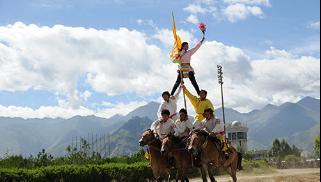 The annual horse race performance is the favorite among Tibetans, and has become a major part of brilliance. There are many items including single-person-single-horse, archery on horse, double-men-double-horse, shooting on horse, flower-basket-picking on horse and so on. These breathtaking and cliffhanging performances display athletes' superb technique and excellent psychological quality, and have been well received by the public and tourists in attendance.
The annual horse race performance is the favorite among Tibetans, and has become a major part of brilliance. There are many items including single-person-single-horse, archery on horse, double-men-double-horse, shooting on horse, flower-basket-picking on horse and so on. These breathtaking and cliffhanging performances display athletes' superb technique and excellent psychological quality, and have been well received by the public and tourists in attendance.
Yak Race
Yak race is a traditional sport in Tibet and special favorite of the Tibetans. Every year during the eighth month comes the Shoton Festival. The people dress up in their best finery and sing and dance to celebrate the banquet. The ancient city Lhasa hugs lots of yak-racing master-hand from all around Tibet. 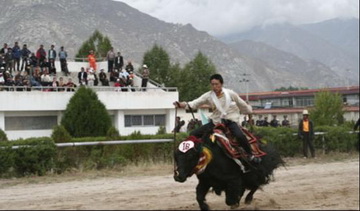 The yaks' massive heads are adorned with red flowers, their backs caparisoned with ornamented saddles. The yak jockeys' whip hands fly as they urge their mounts still faster towards the finish line.
The yaks' massive heads are adorned with red flowers, their backs caparisoned with ornamented saddles. The yak jockeys' whip hands fly as they urge their mounts still faster towards the finish line.


